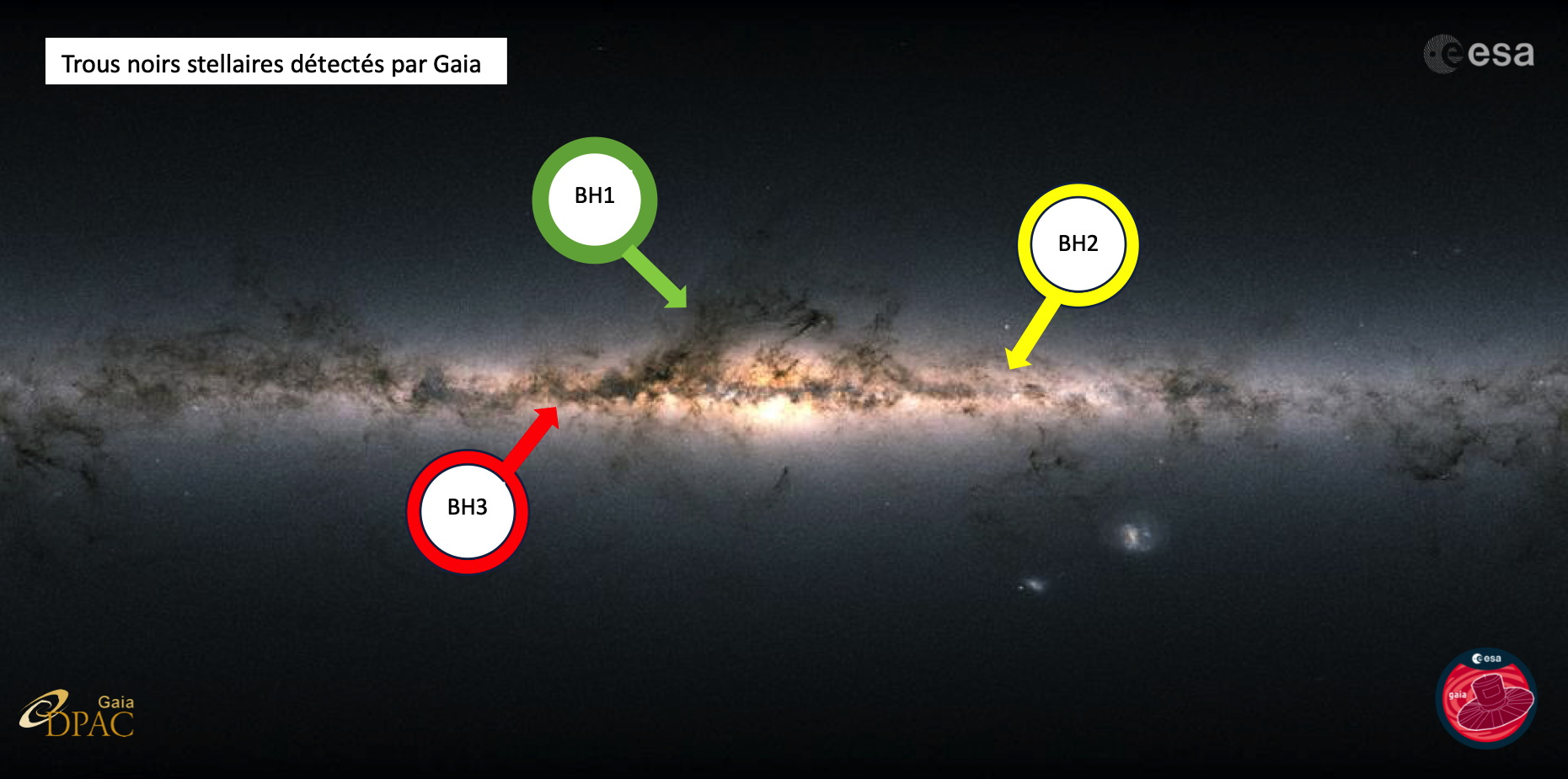Stellar black holes [1] result from the collapse of massive stars at the end of their lives. Theoretical models predict that our galaxy, the Milky Way, could contain a hundred million of them. So far, however, only around twenty have been observed. The vast majority have been identified in binary systems emitting X-rays, the radiation caused by the star’s loss of matter as it is sucked into the black hole around which it orbits. When a black hole doesn’t have a companion star close enough to extract matter from it, it doesn’t emit any radiation. Hence the extreme difficulty of detecting them : they are called "dormant" black holes.
A large-scale astrometric and spectroscopic survey, such as that carried out over the past 10 years by the European Gaia satellite, is ideal for tracking down these dormant black holes, around which a companion orbits. They can be spotted by measuring the perturbations to their star’s motion. In 2023, information published in the third Gaia catalog (Gaia DR3) enabled us to discover the first two dormant black holes in our Galaxy, named Gaia BH1 and Gaia BH2.
As part of the data processing for the publication of the fourth Gaia catalog, DR4, scheduled for the end of 2025, numerous tests were carried out to validate a preliminary solution. In the course of this work, the consortium’s scientists uncovered a new binary system, housing a dormant black hole, named Gaia BH3, located in the Eagle constellation, almost 2,000 light-years away - close enough to Earth, on the scale of our Galaxy.

The mass of this object is exceptional, estimated at almost 33 times that of the Sun, and makes the discovery particularly remarkable. This mass is far greater than that of stellar black holes already known in our Galaxy, typically equivalent to or less than 10 solar masses.
Among the population of stellar black holes known to date within our Galaxy, BH3 is the only one to have a mass comparable to that of black holes detected in distant galaxies by the LIGO/Virgo/KAGRA consortium, via gravitational waves. What’s more, its mass is greater than predicted by most stellar evolution models.
| Video explanation ESA video in English with French subtitles on the Paris Observatory - PSL YouTube channel : – Long version [4:51] – Short version [1:19] |
Characterization of the companion star orbiting Gaia’s black hole BH3 has established that it is an old star in the galactic stellar halo, very poor in elements heavier than hydrogen and helium. The authors of the study deduce that the progenitor of this high-mass black hole was a massive star, also very poor in heavy elements.
The detection of Gaia BH3 also confirms, for the first time, the hypothesis put forward by certain models of stellar evolution, according to which the high-mass black holes observed via gravitational waves outside the Galaxy were produced by the gravitational collapse of massive stars poor in heavy elements.
The discovery of the Gaia BH3 system overturns our understanding of how massive stars evolve and transform into black holes. Its implications are far-reaching, and will probably give rise to a large number of publications in an attempt to find out more.
Collaboration
This discovery is the fruit of the work of the Data Processing and Analysis Consortium (DPAC), which is responsible for processing and analyzing data from ESA’s Gaia satellite, and includes some 450 European engineers and researchers. France has played a leading role in this effort, with some one hundred researchers and engineers from the CNRS, observatories and universities, and the Centre national d’études spatiales (CNES).
In particular, the processing of Gaia’s astrometric binaries and spectroscopic data - the basis for the discovery of this exceptional stellar black hole - is the responsibility of CNRS engineers at Observatoire de Paris - PSL, within the Laboratoire Galaxies, Etoiles, Physique et Instrumentation - GEPI (Observatoire de Paris - PSL / CNRS), with support from the CNES team and computing resources.
This study benefited from complementary observations by ground-based instruments :
- UVES - Ultraviolet and Visual Echelle Spectrograph, on the ESO (European Southern Observatory)Very Large Telescope in Chile.
- HERMES : spectrograph on the Mercator telescope operated in La Palma (Spain) by the University of Leuven (Belgium), in collaboration with the Observatory of the University of Geneva (Switzerland).
- SOPHIE : high-precision spectrograph at the Observatoire de Haute-Provence - OSU Institut Pythéas.
Reference
Gaia Collaboration, Panuzzo P. (CNRS, Observatoire de Paris - PSL), Mazeh T., Arenou F. (CNRS, Observatoire de Paris - PSL), Holl B., Caffau E. (CNRS, Observatoire de Paris - PSL), et al, « Discovery of a dormant 33 solar-mass black hole in pre-release Gaia astrometry » 2024, A&A Letter - https://aanda.org/10.1051/0004-6361/202449763.
Also read on the same subject
Article on the Gaia website - France :
« Gaia BH3, un trou noir extraordinaire ! »
Press release on the ESA website :
« Sleeping giant surprises Gaia scientists »
Image of the week on ESA’s Gaia website :
« Gaia spots Milky Way’s most massive black hole of stellar origin »
Press release on the ESO website :
« Most massive stellar black hole in our galaxy found »
[1] Stellar black holes are different from supermassive black holes at the heart of galaxies, which are incomparably larger
